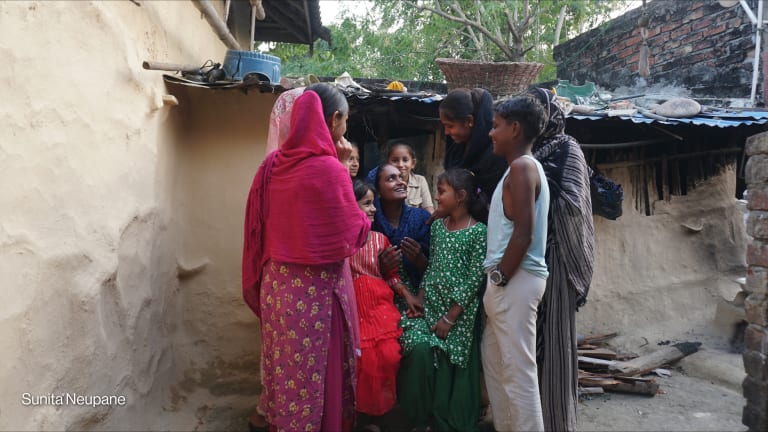Lessons from the great COVID-19 distance learning experiment
The pandemic put ed tech through its paces — and in lower-income settings, it was often outshone by simpler solutions.
The COVID-19 pandemic has been a big moment for education technology. As schools worldwide began to close their doors from February 2020 to contain the coronavirus, students of all ages were forced to study at home — creating a short-notice experiment for distance learning at a greater scale than any ed tech provider could have imagined. What was learned? First, the rush to digital left many students behind. Reaching everyone necessitated a range of options. Second, no matter how classes were delivered, the key takeaway for many experts was that distance learning initiatives must include elements of direct interaction with a teacher, alongside parental or caregiver support, to be effective. In May, UNESCO said 152 governments had introduced distance learning initiatives. Of those, nearly two-thirds relied exclusively on online platforms. Yet almost half of primary and secondary students targeted with national online-only options — or around 465 million children — had no internet access at home. In many lower- and middle-income countries where internet access is limited, ed tech solutions — which are often billed as delivering more engaging, individualized, and inclusive learning — were outshone by low-tech approaches: old-school television and radio broadcasts, sometimes accompanied by printed materials. Twenty-eight governments rolled out distance learning initiatives that relied solely on TV or radio, while 29 others offered these alongside online approaches. According to an analysis of interventions included in a database published by the EdTech Hub, the use of ed tech products in Africa may have doubled early on in the pandemic. But the proportion of children on the continent regularly using these products remained low — at perhaps 6%, according to the estimate by Lee Crawfurd, senior research associate at the Center for Global Development. Even then, most of these children were not using apps, the internet, or mobile devices but were users of a company called Ubongo, which does have an app but is best known for its Sesame Street-style TV shows, Ubongo Kids and Akili and Me, which together are broadcast across dozens of countries. Ubongo said users of its products rose from 13 million to 16.9 million soon after schools closed. There is some evidence that these shows support skills such as mathematics and language. Crawfurd told Devex he believes it would have had “some positive effect” during the pandemic, but there’s a limit to how far television can replace school. “It’s easy to focus on technology [for education], but people often forget that paper itself is technology.” --— David Sengeh, Sierra Leone’s minister of basic and senior secondary education That’s in part because even these relatively low-tech interventions do not reach everyone. UNICEF found that television reaches, at most, half of school-age children in the countries it analyzed in sub-Saharan Africa and South Asia. Among the lowest-income children, 10% or fewer have a television at home. Radio fared better, potentially reaching more than 50% of school-age children in countries such as Gambia, Suriname, Sierra Leone, and Ghana. Even if children can listen or watch, how much do they actually learn? “You need some kind of human engagement to stay motivated and get sufficient feedback,” Crawfurd said. “That’s a hard thing to replace by just broadcasting.” Cristobal Cobo, senior education and technology specialist at the World Bank, agreed that when learning resources are put online or broadcast, there has to be an additional layer of interaction to ensure engagement. “When the supply is only focused on one-way distribution of messages — which has been the strategy for many, many countries delivering messages all over the place through digital and nondigital resources — the take-up is much more limited,” he said. “Teachers following up with their students with a phone call or the parents at home can make a difference.” This interaction can be synchronous — for example, live video calls with teachers and learners interacting at the same time — or asynchronous, with learners accessing prerecorded or published materials alone and interacting at a different time. For example, Brazil supported its educational TV broadcasts with an app that was “zero-rated” — providing online content without data charges — and allowed children to connect with teachers after watching the shows to ask questions. Cobo said this kind of multichannel approach can be the best way to target both urban areas, where children generally have better internet or mobile connectivity, and rural areas where residents may have less digital access. “A wealth of options is a critical element,” he said. A similar approach proved successful in Nepal, where global education charity Street Child provided 560 girls with prerecorded lessons delivered on solar-powered MP3 players, accompanied by paper resources. A socially distanced group of girls would sit around a device to listen together, while a teacher dialed in to clarify questions by phone. “After six months of remote teaching, 75% of girls said they preferred remote teaching and learning to in-person,” said Ramya Madhavan, global head of advisory at the charity. This was because they could do their learning in their own time, around household chores and caring for siblings. According to the charity, assessments carried out after seven weeks of distance learning found significant improvements in reading and math skills, although there is no longer-term data on the impact of the program. Street Child also conducted weekly well-being check-ins with the girls to replicate the social support a school-based environment would provide, amid concern about the impact that being stuck at home would have — especially on girls. Madhavan says this enabled the charity to intervene and prevent three child marriages between March and September last year, after girls reported that plans were being made at home. Some experts stress the need to train teachers on delivering education through technology, which is different from face-to-face interaction. Parental engagement is also key, according to Carla Aerts, founder of ed tech research network Refracted! “In the developing world, targeting parents to convince them to send their child to school has always been important,” she said. “During the pandemic, given that school closures and remote learning came into play, parents got more visibility and involvement in education, where this was possible. The parent engagement is not about sending kids to school; it is about strengthening relationships between schools and parents to support engagement and, in many developing countries, to make sure girls also benefit from remote teaching.” Despite some innovations and successes, the COVID-19 distance learning experiment has exacerbated the educational divide between rich and poor that existed before the pandemic. The United Nations estimates that 23.8 million more children will drop out or not have access to school in 2021 due to the pandemic’s economic impact, and many of those will be girls. To minimize this impact, educators say distance learning solutions must be designed from the bottom up, with the most marginalized as the starting point. “It’s easy to focus on technology, but people often forget that paper itself is technology,” said David Sengeh, Sierra Leone’s minister of basic and senior secondary education. Speaking at the recent launch of an EdTech Hub report on ed tech’s impact during the pandemic, he described how Sierra Leone delivered lessons via printed materials, mobile devices, radio, and television to reach children at all economic levels. “When we work with the stakeholders to develop for the person who is most excluded … then we’re able to design for everybody else,” Sengeh said. Ed tech may not have lived up to its hype. But as Cobo pointed out, the digital resources and approaches created during the past year are likely to remain a part of future education. “These have been integrated as part of the learning experience,” he said, “not to replace in-person learning, but as to enhance, to add an extra layer of value.” Cobo added, “It’s hard to know yet because it’s too early, but we tend to think that some of these multichannel approaches — low-tech and high-tech, synchronous and asynchronous — might remain.”
The COVID-19 pandemic has been a big moment for education technology. As schools worldwide began to close their doors from February 2020 to contain the coronavirus, students of all ages were forced to study at home — creating a short-notice experiment for distance learning at a greater scale than any ed tech provider could have imagined.
What was learned? First, the rush to digital left many students behind. Reaching everyone necessitated a range of options. Second, no matter how classes were delivered, the key takeaway for many experts was that distance learning initiatives must include elements of direct interaction with a teacher, alongside parental or caregiver support, to be effective.
In May, UNESCO said 152 governments had introduced distance learning initiatives. Of those, nearly two-thirds relied exclusively on online platforms. Yet almost half of primary and secondary students targeted with national online-only options — or around 465 million children — had no internet access at home.
This story is forDevex Promembers
Unlock this story now with a 15-day free trial of Devex Pro.
With a Devex Pro subscription you'll get access to deeper analysis and exclusive insights from our reporters and analysts.
Start my free trialRequest a group subscription Printing articles to share with others is a breach of our terms and conditions and copyright policy. Please use the sharing options on the left side of the article. Devex Pro members may share up to 10 articles per month using the Pro share tool ( ).
Gabriella Jóźwiak is an award-winning journalist based in London. Her work on issues and policies affecting children and young people in developing countries and the U.K. has been published in national newspapers and magazines. Having worked in-house for domestic and international development charities, Jóźwiak has a keen interest in organizational development, and has worked as a journalist in several countries across West Africa and South America.






